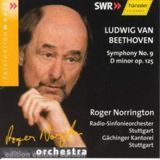|
|
|
|
|
|
|
|
| Musicweb International |
| Colin Clarke |
Ludwig van BEETHOVEN (1770-1827)
|
Symphony No. 9 in D minor, Op. 125, ‘Choral’ [61’28].
|
|
Camilla Nylund (soprano); Iris Vermillion
(mezzo); Jonas Kaufmann (tenor); Franz-Josef Selig (bass);
Gächinger Kantorei, Stuttgart;
South West German Radio Symphony Orchestra, Stuttgart/Roger Norrington.
Recorded live at the Europäisches Musikfest, Stuttgart, 2002. |
|
 Hearing
Sir Roger’s Beethoven symphonies as a cycle rather than piecemeal has its
rewards. One can immediately admire the conviction, the obvious belief in a
viewpoint. At their very best, the performances can emerge as a breath of
fresh air; at the very worst, they are thought-provoking (no bad thing). The
rethinking of standard repertoire at the behest of their Chief Conductor has
seemingly energised the Stuttgart orchestra to great heights, for they play
with great elan and, at times, real virtuosity. These are live performances,
and there can be an edge-of-the-seat energy to them yet very little loss of
accuracy. Certainly there is no doubting the enthusiasm of the audiences for
the end result, cheers appearing regularly after final chords. The orchestra
is mainly modern instrument, with some wind playing copies of period
instruments and valveless brass. Strings use less vibrato than is the norm,
resulting in a convincingly ‘period’ feel. Hearing
Sir Roger’s Beethoven symphonies as a cycle rather than piecemeal has its
rewards. One can immediately admire the conviction, the obvious belief in a
viewpoint. At their very best, the performances can emerge as a breath of
fresh air; at the very worst, they are thought-provoking (no bad thing). The
rethinking of standard repertoire at the behest of their Chief Conductor has
seemingly energised the Stuttgart orchestra to great heights, for they play
with great elan and, at times, real virtuosity. These are live performances,
and there can be an edge-of-the-seat energy to them yet very little loss of
accuracy. Certainly there is no doubting the enthusiasm of the audiences for
the end result, cheers appearing regularly after final chords. The orchestra
is mainly modern instrument, with some wind playing copies of period
instruments and valveless brass. Strings use less vibrato than is the norm,
resulting in a convincingly ‘period’ feel.
...... (Symphonies 1-8 left out)
The Ninth, the greatest of them all, fares well. The first movement is
dynamic, keeping good pace with the swift changes of dynamic and emotion.
Certainly, this is a high-voltage account and that is continued into the
Molto vivace second movement. Amazingly agile, the bullet-like timpani is
the star here. Alas, the rapid speed of the ‘Adagio molto e cantabile’
results once again in a peripheral reading that, despite many delights,
fails to plumb the depths. The finale, too, appears to skim across the
surface. The opening is crass and there is little mystery when the lower
strings announce the ‘Ode to Joy’ theme. Of the vocal soloists,
Franz-Josef Selig gets a bit lost in his melismas, and Kaufmann is notable
for his well-rounded tenor. All four work well together as a group, but just
how large is the chorus?. It sounds small, but amplified by recording
techniques.
The ‘extra’ disc is of lectures (in German) given by Norrington. Although
they regurgitate some of the information in the booklets, they are not at
present available in English elsewhere.
Difficult to give an overall rating for the set. The first three symphonies
are probably the most convincing of the nine. As I said about Nos. 5 and 6
(but it turns out to refer to the entire exercise), Norrington, if nothing
else, is guaranteed to provoke a reaction, good or bad. |
|
|
|
|
|
|
|
|
|
|
|